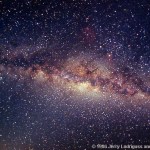milky way
"Look within. Within is the fountain of good, and it will forever bubble up, if forever you dig." -Marcus Aurelius
Welcome back to yet another Messier Monday! Each week, we're taking a look at one of the 110 fixed, deep-sky objects -- not to be confused with comets -- that made up Messier's original catalogue.
Image credit: ScienceSouth - Tony's Astronomy Corner.
Today, we're going to take a look at Messier 52, one of the 33 open star clusters in Messier's catalogue, which happens to be right on the edge of the Milky Way galaxy. It's one of the easiest Messier objects to find, as to get…
"Mortal as I am, I know that I am born for a day. But when I follow at my pleasure the serried multitude of the stars in their circular course, my feet no longer touch the Earth." -Ptolemy
As regular readers here will know, earlier this month I went to Glacier National Park, meeting up with an old friend of mine that I hadn't seen in a few years. What you may not have known is that Rich is not just into photography, but he's recently taken an interest in astrophotography, which I started noticing when he started sending me photos like this.
Image credit: Richard Helmich, from April of 2012…
"It is always wise to look ahead, but difficult to look further than you can see." -Winston Churchill
We've come a long way in this Universe. Over the past 13.7 billion years, we've formed the light elements out of a sea of protons and neutrons, cooled and expanded to form neutral atoms for the first time, gravitationally collapsed hydrogen and helium gas clouds to form the first stars, borne witness to generations of stellar deaths and rebirths, lived through the formation of hundreds of billions of galaxies and the clustering together of thousands or more galaxies into clusters, filaments,…
tags: Galactic Center of Milky Way Rises over Texas Star Party, astronomy, science, stars, Milky Way, streaming video
This fascinating video is a time lapse video of night sky as it passes over the 2009 Texas Star Party in Fort Davis, Texas. In this video, you will see the bright galactic core of the Milky Way crossing the Texas sky. Images taken with 15mm fisheye lens.
The Milky Way galaxy is a relatively big spiral galaxy. So is Andromeda. There are about 20 dwarf galaxies that are gravitationally bound to us; combined with us, all of this makes up the local group. But Andromeda is moving towards us, and eventually, it's going to merge with us. I'll once again show you a video of what this merger might look like:
But what would we see, here in the Milky Way, as Andromeda got closer and closer to us? Right now, Andromeda looks like this:
But Andromeda is also very far away: about 2.3 million light years (770 kpc). The center of it is tiny on the sky, but…
Alright, startswithabang-ers, Ben, my most avid commenter, saw me online while I was eating breakfast this morning, and pointed me to this new press release. Now, before you get started clicking on everything, the guy who the release is about is Brian Gaensler, who's a really nice guy, lives in Australia, whom I met at the AAS (American Astronomical Society) meeting in Austin, TX last month. Bryan's also brilliant.
Basically, what he did was he said, "well, we know what the rough density of hot gas in our galaxy is, and we can measure the timing of these pulsars to extraordinary accuracy."…
Last year, I had just finished my Ph.D. studies, and had moved to Madison, WI to teach introductory physics at the University of Wisconsin. I was working on this paper, and when I submitted it, I got a phone call from New Scientist magazine's space division.
Fast-forward two weeks, and I find this article online, where I got to see my name in print:
Now, scientists led by Ethan Siegel of the University of Wisconsin, in Madison, US, have come up with a new way to potentially reveal blobs of dark matter drifting nearby and perhaps even pin down what it is once and for all.
And I thought to…
I got a great question earlier today from my buddy Zrinka, and decided to figure out the answer for her, and also for myself. She asks:
Ethan, is it possible to know, or better to say to imagine somehow how our galaxy looks from outside?
What a simple-sounding question! After all, we know what the Earth looks like from the outside: we just go outside of it and photograph it. But the galaxy is too big to do that to; it would take tens of thousands of years moving at the speed of light to get that far away! So we're left with the option of looking at our galaxy from inside of it, and trying to…






